Author: Marshall Schott
I’ve always enjoyed split-batch yeast comparisons for two main reasons: it’s an easy way to get 2 somewhat different beers out of a single batch of wort and it satiates my desire for experimentation. When Tommy, owner/brewer of House of Pendragon Brewing Company, asked me to brew up a test batch of a new Honey Blonde Ale recipe he was working on, I jumped at the opportunity and thought this would be a fun one to test out a yeast I’d never used. Tommy has been making HoP English Blonde Ale, fermented with WLP007 Dry English Ale yeast, since the tasting room opened. While a decidedly tasty beer, he has grown rather fond of a different yeast, one that some experience as fickle and tough to work with, a yeast I’ve been touting for the last few years because of how truly incredible it is:
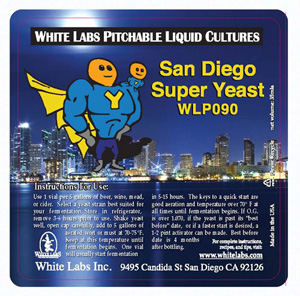
The great WLP090 San Diego Super Yeast. I love this stuff, plain and simple, and the fact Tommy is starting to use it in more of his beers makes me want to have children with him. While the original HoP Blonde is delicious, Tommy was interested in creating a beer with a slightly cleaner yeast profile, a slight balance toward the malt, and a subtle touch of honey character. One of his main goals was to make a palatable craft beer for those who perhaps aren’t necessarily into tooth-enamel-removing IPA or coffee-infused Stout. He shot me the recipe he’d worked out, which I scaled down to my 10 gallon system:
House of Pendragon Honey Blonde Ale Test Batch
Packaging Volume: 10 gallons
Original Gravity: 1.054
Boil Time: 60 Minutes
GRIST
18 lbs US 2-Row (86.7 %)
1.5 lbs Gambrinus Honey Malt (7.2%)
1.25 lbs Gambrinus Munich 10L (6.0%)
HOPS
~9 IBU Fuggles – Boil 60.0 min
91.00 g Fuggles – Flameout/Whirlpool (15 minute steep)
YEAST
1.0 pkg WLP090 – San Diego Super Yeast
PROCESS
– Mash at 153°F for 60 minutes (7.75 gallons)
– Sparge with 170°F water (8 gallons)
– Chill to 64°F prior to pitching yeast starter
– Ferment at 66°F for 3-4 days then allow to free rise up to 72° over the next week
– Cold crash for 24+ hours after FG is stable (10-14 days) then keg
Again, Tommy was most interested in how San Diego Super Yeast (090) would play with the honey malt and Fuggles hops, but I wanted to get 2 kegs of somewhat different beer out of this batch, so I made the trek to a local homebrew shop to peruse the yeast selection. Since I’d be fermenting the 090 batch at its sweet spot of 66°F and the other carboy would be in the same chamber, I knew I’d have to go with another ale yeast that worked well at that temp. I’d used most of the liquid yeasts carried by this particular shop, which is only White Labs, but there was one my eyes kept falling on that I hadn’t played with: WLP051 California Ale V yeast (051). A quick search of the White Labs website yielded the following description:
From Northern California. This strain is more fruity than California Ale yeast and slightly more flocculent. Attenuation is lower, resulting in a fuller bodied beer than with the California Ale strain.
Sounded good to me! I actually read elsewhere that this strain was originally from Anchor Liberty Ale, one of the first American examples of an IPA. Not being a big fan of WLP001 (at all), I thought this might be a neat yeast to compare to 090, as the descriptions were sort of similar. I grabbed the vial and headed home to get a couple starters going for a brew day 2 days later.
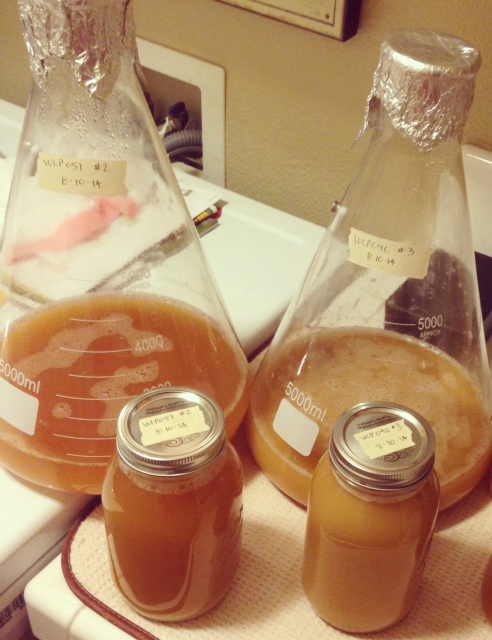
The night before brewing and after stealing some yeast for future use, I put the starters in the cool fermentation chamber to crash. I woke up early the following morning, brought my strike water to temp, and mashed in.
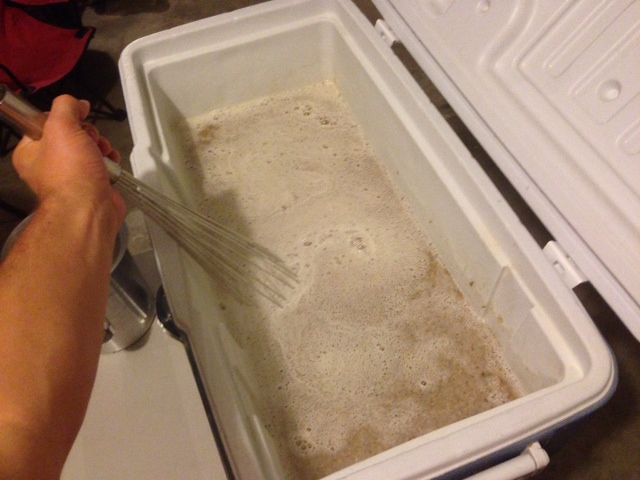
An hour later, the mash was complete and it was time to collect the first runnings.
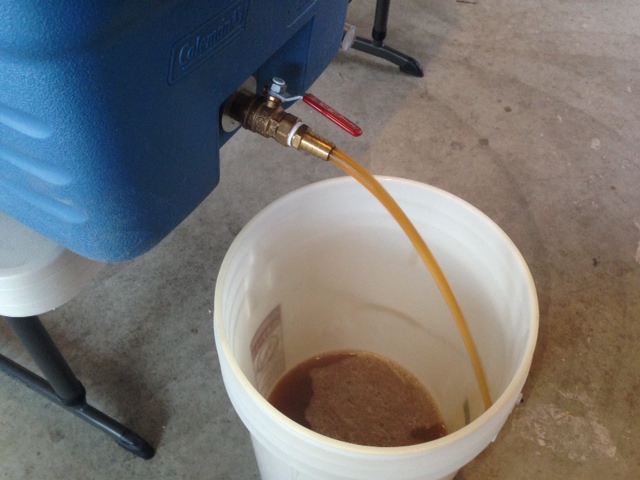
The sparge water was added, second runnings collected, the sweet smelling wort was brought to a rolling boil, and the bittering charge of Fuggles was thrown into the kettle.
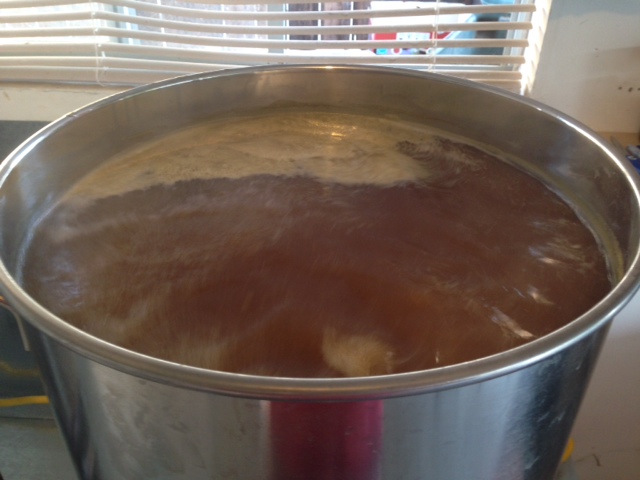
When the 60 minute boil was complete, I cut the flame and tossed in the large charge (nearly 3.25 oz) of Fuggles.
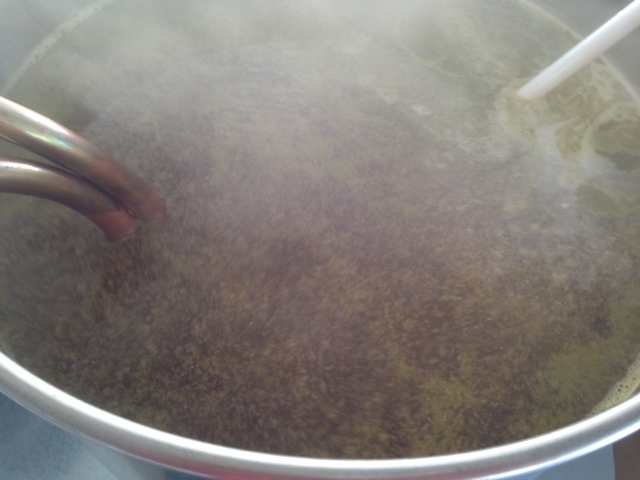
Following a 15 minute steep, I turned my water on full blast and used my King Cobra IC to chill the wort. Even with 75°F groundwater, it only took 9 minutes to chill nearly 12 gallons of 200°F wort to 81°F. The full carboys were placed in a cool ferm chamber to finish chilling to my target pitching temp of 64°F, at which point each yeast was added and my ale profile on The Black Box temp controller was engaged.

One of the more interesting things about these split-batch yeast comparisons is observing the variation in fermentation, as usually there are some rather noticeable differences. Oddly, these 2 beers looked like they were pitched with the same strain, something I’d rarely witnessed.
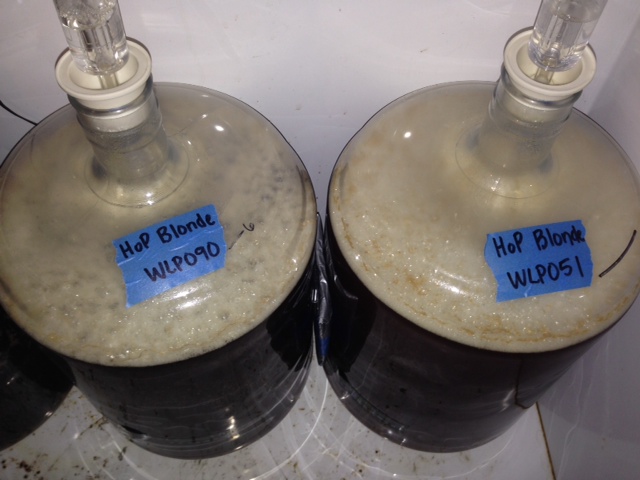
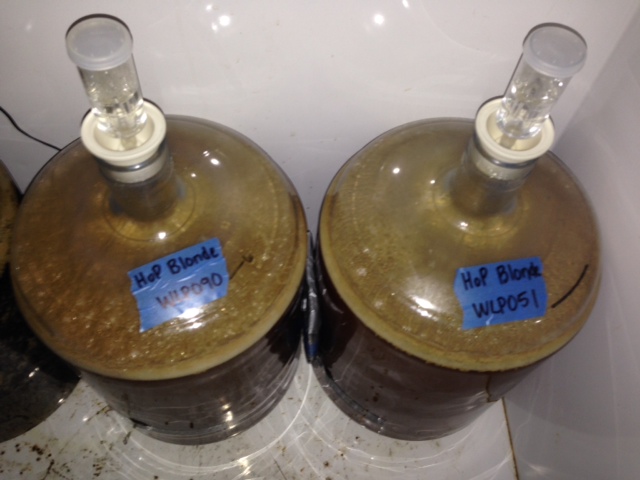
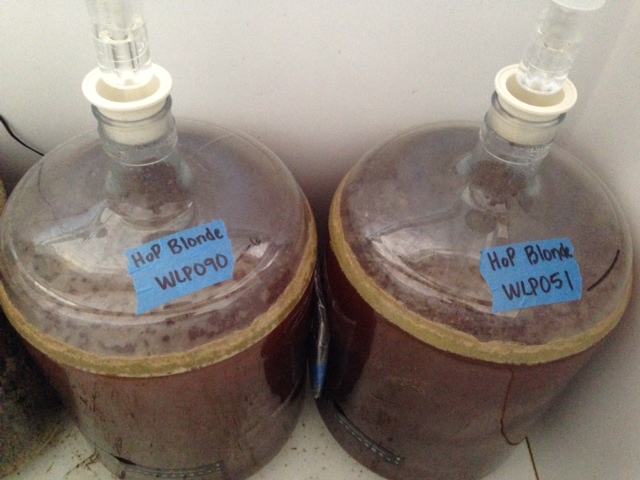
Any observed differences during fermentation were slight, even the krausen dropped around the same time. It was at this point I measured the FG of both beers and noticed the first difference.
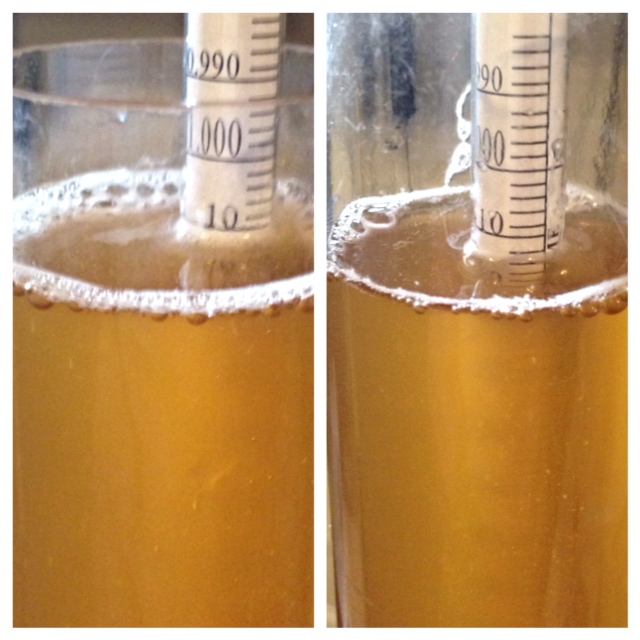
The SDSY beer was .001 SG point lower than the 051 batch, which makes sense given the information provided by White Labs regarding attenuation rates of each yeast. I also tasted each hydrometer sample, both were good, but definitely different. I let the beers sit another 24 hours, ensured FG hadn’t changed, then proceeded to keg the beers using one of my favorite tools, the sterile siphon starter.
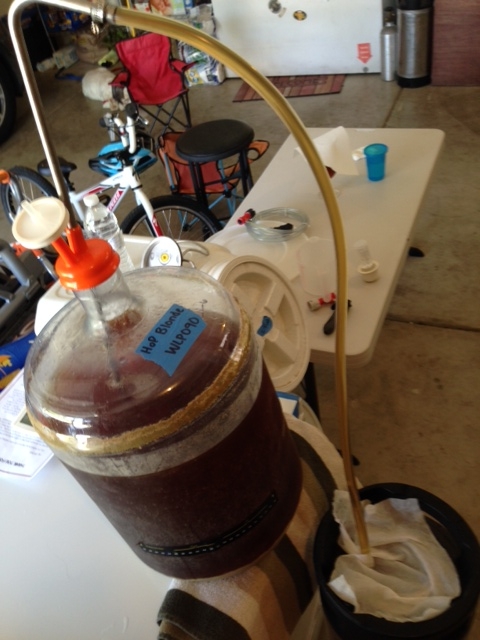
Both kegs were placed in the keezer, hit with 30 psi of CO2 for 36 hours, then purged and put on 12 psi for another few days before being tapped. Surprisingly, both had cleared rather significantly by the time I started serving them.
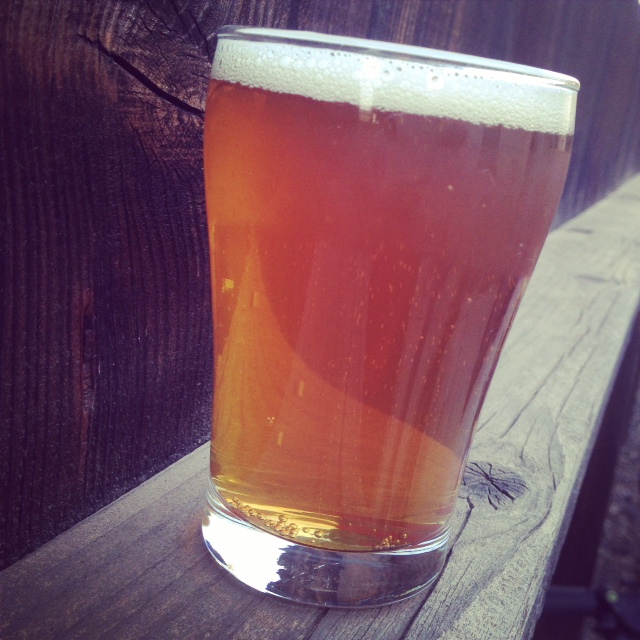
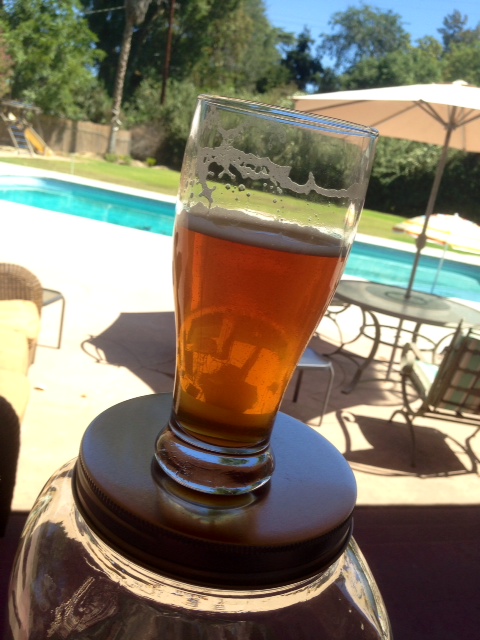
While the photos above seem to show the 051 beer as being clearer, this is likely a function of the environment the photo was taken in, as in side-by-side comparisons, both beers look exactly the same– very clear.
| IMPRESSIONS |
I casually shared both beers with friends and asked for their opinions on the differences, all of whom knew they were fermented with different yeasts. This was not a blind evaluation but more of a simple comparison, which was a nice departure from the very structured and scientifically sound exBEERiments I’ve been doing 😉
I was initially intending to list the tasting notes of some of the folks who tasted the beers, but interestingly, our comments basically aligned. Here’s what we thought:
WLP051 California V Ale Yeast
Most experienced this beer as being fairly well balanced with a clean and perhaps slightly fruity yeast character. Despite the large flameout charge of Fuggles, the 051 beer was not described as having a strong hop character by anyone. Just a few days after being kegged, a few tasters, myself included, noted a distinct sulfur character in the beer, though this appeared to dissipate over time, to the point of complete absence in later tastings. This beer had a light to medium body with a somewhat crisp mouthfeel and good carbonation. The flavor of the honey malt was not necessarily prominent in this beer, but certainly noticeable, imparting a subtle sweet nuttiness that made for some easy-drinking. Overall, this was an enjoyable beer, especially while wading in a pool eating grilled burgers with friends on a 105°F Fresno summer day.
WLP090 San Diego Super Yeast
Nearly everyone who tasted these beers commented that the half fermented with 090 had a noticeably stronger honey character, not that it was sweeter (FG was actually lower), just that the honey flavor was much more noticeable. Likewise, there was a strong floral character balanced by a delectable earthiness, which we agreed was likely a result of large flameout hop addition. One taster… ahem… described it as sucking on a honey stick while walking through a field of wildflowers, just without the sticky sweetness. The mouthfeel on this beer was generally perceived as being slightly creamier than the 051 batch with more of a solid medium body and good carbonation.
| THE VERDICT |
The WLP090 beer was the unanimous favorite, though everyone agreed the WLP051 batch was still delicious. I’m an advocate of the idea that quality ingredients produce quality beer and, in this case, I truly believe our use of Gambrinus’ Honey Malt and and Munich 10L contributed to deliciousness of both beers. In fact, if you haven’t tried grains from this Canadian maltster, I strongly encourage you to seek them out, I’ve yet to be let down! While I’ll likely not use 051 very often, only because 090 has always proven itself to be a badass in any style I’ve used it on, I did learn it absolutely produces a clean, malt-forward, and tasty beer! I think it’d work beautifully in anything from Pale Ale to Porter and perhaps even some English styles.
If you’re wondering what Tommy decided to do, well… after a few of his trusted friends tasted the hydrometer samples and gave very positive feedback, he went ahead and brewed it up, though I think he reduced the flameout addition just a hair. He then left on a trip and has still yet to taste the finished beer. I believe, though I’m not terribly certain, his version will be on tap this coming weekend (9/6/2014). If you’re in the vicinity, head over to the House of Pendragon tasting room and enjoy some Honey Blonde along with the plethora of other delicious beers currently on tap.
Please do not hesitate to ask questions or comment below. Cheers!
Support Brülosophy In Style!
All designs are available in various colors and sizes on Amazon!
Follow Brülosophy on:
FACEBOOK | TWITTER | INSTAGRAM
| Read More |
18 Ideas to Help Simplify Your Brew Day
7 Considerations for Making Better Homebrew
List of completed exBEERiments
How-to: Harvest yeast from starters
How-to: Make a lager in less than a month
| Good Deals |
Brand New 5 gallon ball lock kegs discounted to $75 at Adventures in Homebrewing
ThermoWorks Super-Fast Pocket Thermometer On Sale for $19 – $10 discount
Sale and Clearance Items at MoreBeer.com
If you enjoy this stuff and feel compelled to support Brulosophy.com, please check out the Support Us page for details on how you can very easily do so. Thanks!











18 thoughts on “exBEERiment | Yeast Comparison: WLP090 San Diego Super Yeast vs. WLP051 California Ale V In A Blonde Ale”
I just played with these two yeasts as well, albeit on totally different beers. I used 051 on an ESB and the 090 on an IPA. Both fermented well and completely, both cleared up well. The 051 didn’t have as fruity a character as I was looking for, but it was fine. The 090 (in my first attempt at all grain IPA) produced a damn fine beer, if I say so myself, and I do. Despite missing my OG (due to a bad case of stupid on my part) the final product was nearly perfect, in that it was what I imagined when I created the recipe. The 090 was some of the best yeast I’ve ever used. It may become my ‘house’ yeast for ales.
Nice exBeeriment, even without the precise, irrefutable, and unerringly accurate scientific evidence you normally produce.
Awesome, John! I always get a little excited when I hear others enjoy 090 as much as me. I’m so curious what the original source for this yeast was, I’ve heard Port Brewing, but nothing conclusive. Cheers!
I did a split batch experiment last year using 090 and 060 on a DIPA. Surprisingly the 090 batch (which had a lower FG) was noticeably sweeter than the 060 and produced a much more balanced beer. Unfortunately it’s not often I can get my hands on 090 down here (Australia) but when I can, it’s one of my favourites. I love reading about these exBeeriments!
So tell me what is your opposition to CA 001? I guess I default to this yeast when brewing IPAs.
Thanks for the great info!
I experience it as one denationalize and boring. The majority of breweries use it and all their beers taste the same. Yeasts that impart a little more character are far more interesting to me. Next time you make IPA, consider using 090 or even mashing lower and pitching 002, the beer will be completely different!
Will do. What would you use for a winter warmer?
090!!!
Thanks for another great post, I am really keen to do a few split batch experiments myself and am now very interested in trying 090. Would you use 090 for something like an English Special Bitter?
As a fairly new homebrewer, I am extremely interested to see a post on your fermentation process. I understood consistent fermentation temp to be very important, but you seem to have at least 3 temps in your profile – pitch at 64, ferment at 66, rise to 72. What’s your reasoning behind each step?
Thanks again.
Thanks for the support! Fermentation temperature is probably the most essential component to making good beer, at least in my experience. Perhaps I’ll pen an entire post on why I ferment the way I do, which I thought was much more common than it apparently is, but the basic principle behind my approach is that yeast derived off-flavors/aromas are produced during the growth phase, which usually occurs during the first 3-5 days of fermentation– this is where temp control is the most critical. Once the yeast moves past this phase, the risk of creating these off-flavors is significantly reduced and the goal shifts from discouraging esters/phenols to encouraging complete attenuation, which warmer temps do. Stable fermentation temps will usually work just fine, especially for ale, but I find that ramping temps after a couple days not only ensures attenuation, but allows be turn a batch around a bit quicker. Hope that helps!
I see your ball valve is opened wide while lautering. I always heard against doing that; that I should lauter slowly. Maybe this is common knowledge, but I’m a fairly new homebrewer.
** TL;DR : Does lautering speed mater ? **
Have you exBEERmented its effect (on efficiency) ?
I’d certainly like to speed up my brew day, and your other exBEERiments surely helped (trub, mash time) !
Thanks
Lautering speed matters when you fly sparge as slower flows tend to reduce the risk of channeling. Since I batch and no sparge, channeling isn’t really an issue. I’ve done slow and fast with no noticeable difference in efficiency or quality of the finished beer.
Nice! Thanks! As I don’t fly sparge (and am beginning to no-sparge occasionnaly), this bit of info probably trimmed 30 minutes from by brew day!
Thanks!
Random Question: My homebrew club is doing a “cereal beer” competition. We picked cereals at random from a hat and have to produce a beer of some resemblance to the cereal using a malt bill and no extra adjuncts other than the cereal. I drew honey bunches of oats with almonds… any thoughts on how you might tweak this recipe to get a nuttiness or a granola / oat flavor. thanks
Ohh, one of my favorite cereals! I seem to get the most nuttiness from Pale Chocolate malt, 4-6 oz per 5 gal batch. I might recommend swapping the Munich with Vienna and maybe use Pils instead of 2-row to add a whisper of that bready character.
Always enjoy your posts, thanks for the many informative write-ups. I also enjoy experimenting with yeasts, with one upcoming batch (patersbierish) to be spit between WLP500, WLP530, WLP540 and WLP550, another (funky blonde that I usually ferment on apricots or raspberries+blackberries, but ‘naked’ this time) split between four Bretts. (WLP645 Brett Claussenii, Avery22 Brett Drie culture, Allagash Midnight Brett culture, and WLP640 Brett Anomalus – previously it’s just the BrettC or blend of first three).
But tomorrow I plan a strange one – a Kentucky Common with rye, fermented with both WLP090 and WLP810 in primary at 64F. Just because. Any predictions on outcome of this blend? Previous KC batch used just the 810, I wasn’t overwhelmed with the result, possibly because I think it hit 68F. (weaker temp monitoring and control on my 1-gallon batches)
Previous multi-yeast batches I’ve done were either multiple Bretts or WY3711 co-pitched or in secondary with different abbey yeasts.
I’m sorry Marshall, but you have NEVER done a structured nor a scientifically sound experiment. Your taste tests have ZERO data, only anecdotal information. Until you submit your beers to a lab to actually test the differences, you will never prove anything. While taste may be a facet of good beer making, you cannot in good faith or conscience state that you’ve ever proven/disproven anything.
Hello! Not Marshall. Just Matt.
>but you have NEVER done a structured nor a scientifically sound experiment
Quite possibly not scientific, depending on your definition, but all of them are structured. Whether you agree or disagree with that structure is definitely up for debate, and our process is open to criticism. But there’s a structure, whether or not you believe it is an effective one.
>Your taste tests have ZERO data, only anecdotal information.
Strictly not true. Our anecdotal reports on the beer are sort of supporting, fluff information in contrast to the data gathered via triangle testing. That information isn’t anecdotal whatsoever, no opinion or personal-experience info, just a collection of “A, B, or C” responses. That is data, triangle testing is used quite frequently in different disciplines. It is only one method of testing, absolutely, but it is a method.
> Until you submit your beers to a lab to actually test the differences
We’ve done this actually! Quite a few times, mostly regarding IBUs but also post-fermentation DO. Even with chemical differences, there seems to be some difficulty in a group’s ability to reliable distinguish said beers.
>you cannot in good faith or conscience state that you’ve ever proven/disproven anything
Of course! And we don’t. No interest at all in “proving” or “disproving”, that’s not the point of the exbeeriments. Xbmts are all contextual. Can this select group of tasters reliable distinguish these two beers of this specific style made in this specific way? Not to prove or disprove, just to gather a data point.
Hope this helps your frame of reference for the work!
Don’t apologize! Your opinion is valid around here.